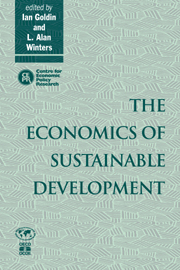Book contents
- Frontmatter
- Contents
- List of figures
- List of tables
- Preface
- Acknowledgements
- List of conference participants
- 1 Economic policies for sustainable development
- PART ONE GROWTH AND THE ENVIRONMENT
- PART TWO SUSTAINABILITY
- 4 What sustains economic development?
- Discussion
- 5 Optimal development and the idea of net national product
- Discussion
- 6 Sustainable growth and the Green Golden Rule
- Discussion
- PART THREE DOMESTIC POLICY
- PART FOUR INTERNATIONAL POLICY COORDINATION
- Index
6 - Sustainable growth and the Green Golden Rule
Published online by Cambridge University Press: 04 August 2010
- Frontmatter
- Contents
- List of figures
- List of tables
- Preface
- Acknowledgements
- List of conference participants
- 1 Economic policies for sustainable development
- PART ONE GROWTH AND THE ENVIRONMENT
- PART TWO SUSTAINABILITY
- 4 What sustains economic development?
- Discussion
- 5 Optimal development and the idea of net national product
- Discussion
- 6 Sustainable growth and the Green Golden Rule
- Discussion
- PART THREE DOMESTIC POLICY
- PART FOUR INTERNATIONAL POLICY COORDINATION
- Index
Summary
Introduction
The concept of ‘sustainability’
The concept of ‘sustainable growth’ is an appealing but elusive one. There are two factors common to most discussions and definitions of sustainability. One is the need to follow development strategies consistent with the planet's endowments. A clear statement of this can be found in the Bariloche model (Herrera et al., 1976; see also Chichilnisky, 1977), whose authors remarked:
The underdeveloped countries cannot advance by retracing the steps followed in the past by the now developed countries: … not only because of the historic improbability of such a retracing being feasible … but … because it is not desirable. It would imply repeating those errors that have lead to the current situation of … deterioration of the environment … The solution … must be based on the creation of a society that is intrinsically compatible with its environment.
In economic terms, following development strategies consistent with the planet's endowments means recognising the importance of resource and environmental constraints and the limitations that they may impose on growth patterns.
A second common factor is an emphasis on equity, both within and between generations. The authors of the Bariloche model emphasised this through the introduction and analysis of the concept of the satisfaction of basic needs as a development priority. The Brundtland Report's (1987) reference to sustainable development includes an emphasis on needs and on intergenerational equity:
Sustainable development is development that meets the needs of the present without compromising the ability of future generations to meet their own needs.
- Type
- Chapter
- Information
- The Economics of Sustainable Development , pp. 147 - 166Publisher: Cambridge University PressPrint publication year: 1995
- 7
- Cited by



